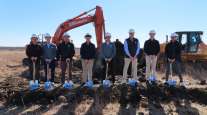Is the Next 'Inland Empire' in Pennsylvania?
With its proximity to the ports of New York, robust interstate system and rapid growth in distribution centers, the Lehigh Valley in Pennsylvania could be poised to become the nation's second "Inland Empire" for freight, joining the one just east of Los Angeles, according to an expert panel that gathered Sept. 7 in Bethlehem for the Lehigh Valley Planning Commission's annual Build LV development summit at SteelStacks.
As the region's warehouse market footprint bulges and grows together with a neighboring market in the Harrisburg area, it is poised to create one large pipeline of warehouse and logistics centers serving the entire Northeast, said Brian Knowles, a principal in national real estate broker Lee & Associates.
While planners touted the increased tax base and thousands of jobs it could create, drivers who have to share the road with all that new truck traffic may be less excited.
"We have the infrastructure, we have the population base and we have the available space to be on that level," Knowles said in comparing the Lehigh Valley with California's Inland Empire. "We have the capacity and when you consider that we're just scratching the surface on e-commerce, we're going to need a lot more inventory. Growth is almost inevitable."
That kind of growth and the truck traffic that comes with it won't come as a surprise to Planning Commission officials, who released their annual development report during the three-hour event that was co-hosted by the Urban Land Institute of Philadelphia.
Noting that 90% of all freight though the valley is moved by truck, Planning Commission Executive Director Becky Bradley already has forecast that the 40 million tons of freight that passes through the valley each year will double by 2040.
That kind of growth has planners comparing this region with what's known as the Inland Empire, a two-county region just east of the Port of Los Angeles. It was once known for its citrus crops, but with the port receiving 176 million tons of cargo a year, it's now more prominent for the 360 million square feet of warehouse, distribution and industrial facilities that dot its interstates.
The Lehigh Valley and neighboring Harrisburg regions are positioned to grow into an "Inland Empire East," Knowles said.
All those warehouse owners will be paying millions of dollars in taxes and likely creating thousands of jobs, but is that worth adding traffic to the highways and chewing up hundreds — and maybe thousands — of acres of green space to do it?
The answer is an emphatic no for Scott Slingerland, director of the Coalition for Alternative Transportation, which promotes pedestrian and bicycle safety and the reduction of congestion through mass transit and ride-sharing.
"With a growing number of warehouses, we lose our sense of place. They're so huge, it almost makes an area seem less habitable," Slingerland said. "There has to be a better way to use this land."
Matthew Tuerk, a vice president at Lehigh Valley Economic Development Corp., stressed that not all new facilities that park along Interstate 78, I-81 or Route 22 will be giant distribution facilities. Many will follow in the mold of Ocean Spray in Breinigsville or industrial pump maker Curtiss-Wright in Bethlehem to make products, creating jobs that pay more than the $12 to $14 an hour warehouse facilities pay.
"I'd say that 60% of the companies that come to us are looking to make something here," Tuerk said. "We will not become some wasteland of warehouse and distribution centers."
But the task of the panel was not to debate whether this transformation should happen, but rather to discuss whether all the signs suggest that it will, Knowles said.
Being close to the ports of New York and New Jersey — connected by a robust interstate system — gives the valley an inherent advantage when attracting new e-commerce businesses.
From there, forecasting where development will happen is based on a complex matrix of factors, but the three key factors suggesting a continued warehouse and distribution boom in the Lehigh Valley are fairly simple, Knowles said.
For one, the combined big box industrial inventory — defined by Knowles as buildings of more than 100,000 square feet — of the Lehigh Valley and Harrisburg region already has topped 200 million square feet, thanks to rapid building in the past five years.
That's well short of the nearly 370 million square feet in California. However, industrial land in the valley and Harrisburg regions that already has been proposed for big box industrial development would support an additional 47 million square feet in just the next few years, he said.
But the biggest factor probably is population, the panel agreed. While that bulging western Inland Empire sits within 300 miles of 28 million people, the burgeoning one in the East has 68 million people in that same 300-mile radius.
With the growth of e-commerce and one-day delivery prompting more companies looking to get products to their customers, they're going to need more distribution centers in that population zone.
"The density, capacity and velocity of truck traffic on interstates 78 and 81 is going to keep coming," Knowles said. "You might as well get ready for it."
It's possible that municipal planners that oppose the warehouses could choose not to approve the projects, but with nearly 50 million square feet of projects already proposed for land zoned industrial, that's unlikely, Knowles said.
As director of a tiny Bethlehem-based organization, Slingerland has grown used to losing these kinds of battles, but he tried to find a nugget of hope to cling onto in this one.
"These are monster facilities," Slingerland said. "Maybe at the very least they can put solar panels on the roof."




